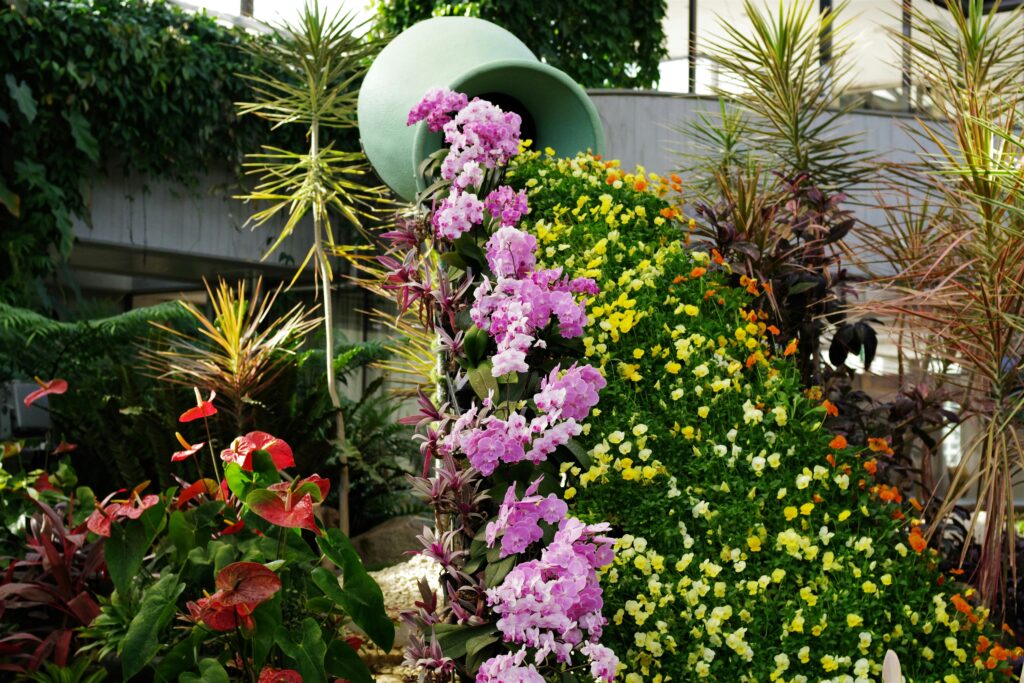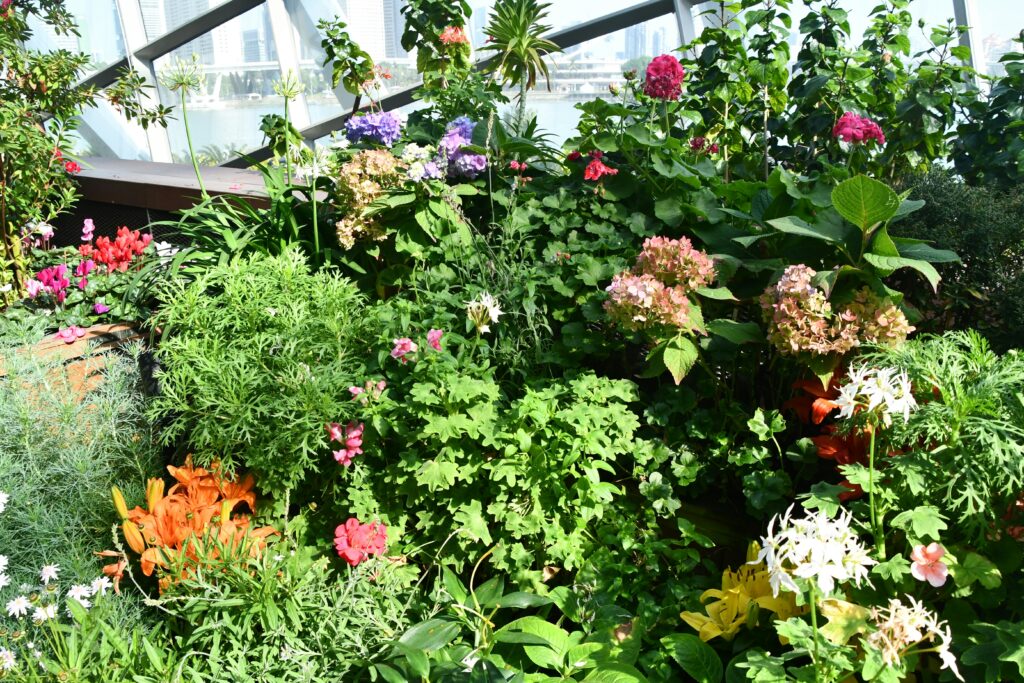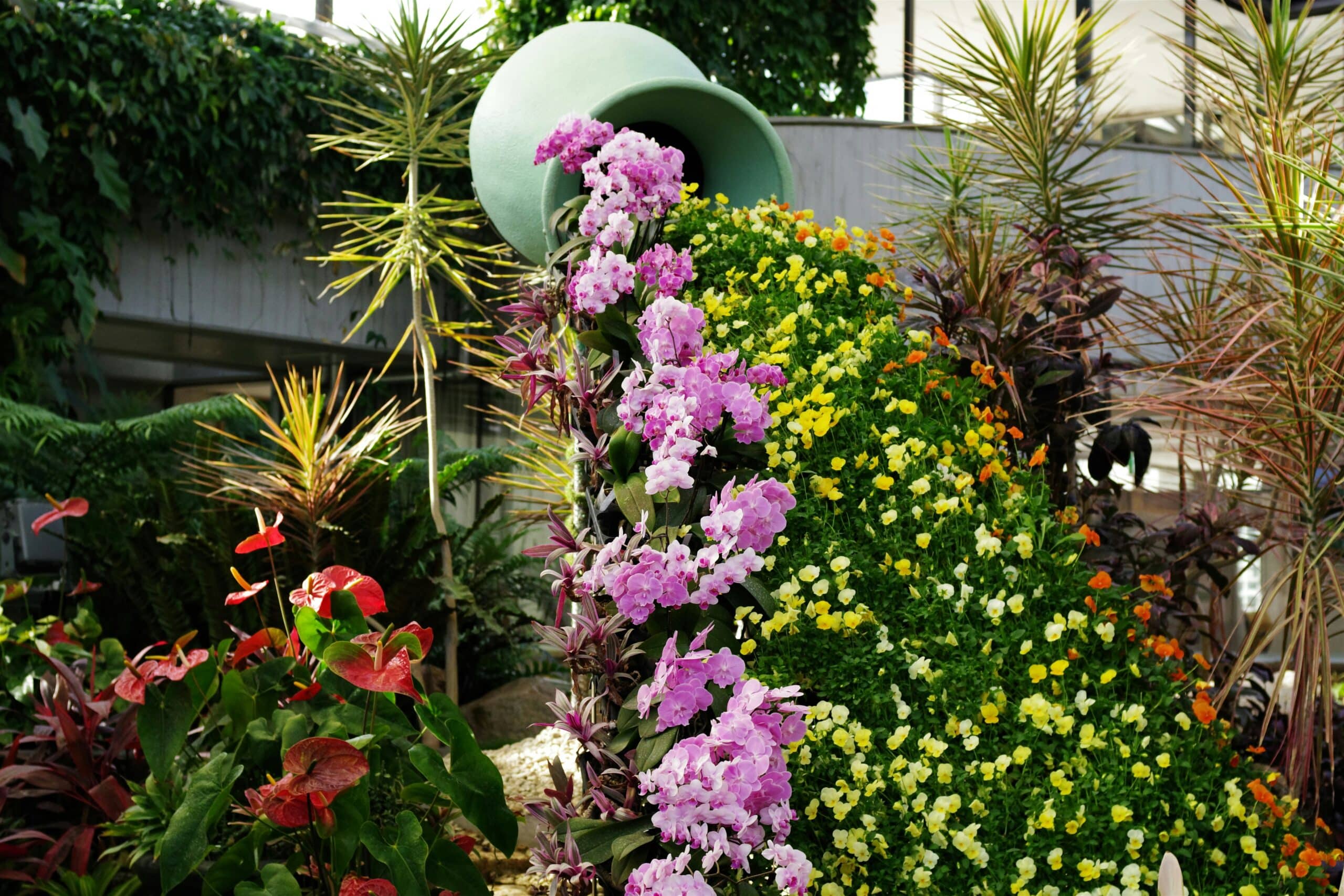Anúncios

Envision the aesthetic appeal and relaxing ambiance that a vertical garden can provide, even in areas with low light. It’s not a far-fetched dream – it’s entirely possible, and we’re here to guide you on your journey to create such a verdant paradise.
This post is going to explore the realm of low-light vertical gardening, a gardening method that combines the principles of horticulture with vertical space utilization. We’ll guide you through choosing the perfect plant picks that thrive in low light conditions, transforming your space into an attractive, living work of art. Think of it as a masterclass in creating a visually stunning, oxygen-boosting green corner that thrives despite the lack of sunlight.
Anúncios
Ready to breathe new life into your environment? Whether you’re a seasoned gardener looking for a new challenge or a beginner eager to make the most of your indoor space, this comprehensive guide is the key to your flourishing indoor garden. Dive in to learn about the best low-light plants for your vertical garden and start illuminating your space with Mother Nature’s own lush, living art. 🌱🌿🍃
Understanding the Basics of Low-Light Vertical Gardening
Low-light vertical gardening is an innovative approach to horticulture that is based on the concept of maximizing the use of vertical space in poorly lit areas. This method relies on selecting the right type of plants that are capable of thriving in low light conditions, thus ensuring a lush and vibrant environment. It’s a perfect solution for city dwellers who are limited by a lack of natural light and space.
Anúncios
The Science Behind Low-Light Plants
The ability of plants to grow in low-light conditions is a result of their evolutionary adaptations. Some plants have evolved in the understories of forests where sunlight is limited. These species have developed the ability to photosynthesize efficiently under low light intensities. In simple terms, they have become experts at capturing and using every bit of light they receive.
Selecting the Right Low-Light Plants for Your Vertical Garden
When planning a vertical garden in a low-light environment, it’s essential to select the appropriate plants. These should be species that can not only survive but also thrive in less light.
Snake Plant (Sansevieria trifasciata)
The Snake Plant, also known as Mother-in-law’s Tongue, is a popular choice for indoor and low-light gardens. Its long, tall, sword-like leaves make it an ideal candidate for vertical gardens.
ZZ Plant (Zamioculcas zamiifolia)
The ZZ Plant is another excellent choice. It’s a hardy plant that can survive in a range of conditions, including low light and irregular watering.
English Ivy (Hedera helix)
This classic indoor plant is known for its trailing vines, which are perfect for vertical gardens. English Ivy thrives in shady conditions and adds a touch of elegance to your garden.
Designing Your Low-Light Vertical Garden
Once you’ve thoughtfully selected a collection of suitable, shade-tolerant plants that are capable of thriving in minimal light conditions, the next crucial step is to carefully design and structure your vertical garden layout. Effective and strategic design is essential not only for the garden’s overall visual appeal but also for ensuring that each plant receives the appropriate amount of light, water, and airflow necessary for healthy and sustained growth.
Designing a vertical garden is both a creative and functional process. While aesthetic considerations—such as color harmony, texture variation, and balance—are important, the garden’s physical layout must also be optimized for plant survival in a low-light setting. The decisions you make at this stage will directly influence the long-term health and success of your vertical garden.
Proper Arrangement for Optimal Growth and Light Exposure
A key principle in designing a low-light vertical garden is the proper arrangement of plants within the vertical framework. Since vertical gardens are arranged on walls or standing structures, the positioning of each plant becomes critically important—especially in areas where natural light is scarce or unevenly distributed.
To maximize light exposure for all plants, it is advisable to place taller plants at the top of the structure. This ensures that they do not block the limited light from reaching smaller or shorter plants below. Tall plants also tend to have more extensive foliage, which can cast shadows if placed in lower positions. Elevating them allows for better light penetration throughout the vertical plane and creates a cascading effect that enhances visual interest.
Smaller, more compact plants should be positioned toward the bottom or in shaded mid-sections of the garden. Many of these species, such as mosses, small ferns, or trailing vines, are better adapted to low-light environments and can still flourish in positions that receive diffused or reflected light. Placing them lower down also makes it easier to monitor and maintain them, as they tend to be more delicate and benefit from closer inspection.
When arranging plants, also consider their growth habits—whether they are upright, trailing, or spreading—and place them accordingly. Trailing plants can be allowed to drape downward from higher levels, softening the structure and creating a layered look, while upright growers are better suited for fixed, central positions where they can maintain vertical integrity without overshadowing others.
Spacing is another essential aspect of arrangement. Ensure that each plant has enough room to breathe and grow without being crowded. Overcrowding can lead to poor air circulation, increased humidity, and the spread of pests or fungal diseases—especially in low-light environments where moisture tends to linger.
By thoughtfully arranging your plants based on their size, light needs, and growth behavior, you set the stage for a vertical garden that is not only aesthetically pleasing but also healthy, balanced, and long-lasting.
Watering System
An efficient watering system is crucial in a vertical garden to ensure every plant gets adequate water. You can opt for a drip irrigation system, a soaker hose, or even a customized watering grid.
Maintaining Your Low-Light Vertical Garden
Caring for a vertical garden situated in a low-light environment presents a unique set of challenges and responsibilities that differ significantly from those associated with maintaining a traditional horizontal garden. Because of the vertical orientation and the inherent limitations of reduced light exposure, it becomes crucial to implement specialized maintenance strategies that cater to the specific needs of the plants. This will help ensure that the vertical garden remains healthy, vibrant, well-balanced, and visually appealing throughout the year.
Unlike standard gardens where sunlight typically reaches most plants evenly, vertical gardens may have uneven lighting distribution, with upper levels potentially receiving slightly more ambient light than lower levels. Therefore, proper and consistent maintenance is essential to make sure that every plant within the structure thrives regardless of its position.
Regular Pruning: A Key to Health and Visual Harmony
One of the most critical and frequently overlooked aspects of maintaining a thriving low-light vertical garden is consistent and careful pruning. Regular pruning is absolutely essential not only for controlling the overall growth of the plants but also for preserving the structural integrity, visual harmony, and neat appearance of the garden wall. Without periodic trimming, plants can become overgrown, unruly, or begin to encroach on neighboring plant space, which can lead to a decline in air circulation, plant health, and aesthetic balance.
Additionally, pruning plays an important role in maximizing the limited light available in low-light settings. When plants are allowed to grow unchecked, they may begin to block light from reaching the lower sections of the garden or cause overshadowing of adjacent species. By regularly trimming excess foliage and removing dead, yellowing, or damaged leaves, you can ensure that light is distributed more evenly and that each plant has an optimal chance to absorb the necessary nutrients and light to flourish.
Moreover, pruning encourages new and healthier growth by redirecting the plant’s energy toward stronger stems and fresh leaves. It also helps prevent issues related to overcrowding, fungal infections, or pests, all of which can quickly become problematic in dense vertical arrangements.
To enhance the visual appeal, consider shaping the plants during pruning to maintain symmetry and balance within the entire structure. Some gardeners opt to train vines to grow along particular paths or to keep foliage confined within designated sections of the garden wall, thereby creating artistic patterns and organized layouts.
Fertilization
Providing the right nutrients is important for the health of your garden. Make sure you choose a balanced fertilizer that’s suitable for your chosen plants.
Benefits of Low-Light Vertical Gardens
Vertical gardening in low-light conditions offers a multitude of valuable benefits for both homeowners and urban dwellers seeking to incorporate greenery into their living environments. This innovative and adaptive gardening technique provides a creative and space-efficient solution for bringing natural beauty and vibrant plant life into areas where traditional gardening methods may not be practical or feasible, particularly in spaces with limited sunlight exposure.
Space-Saving and Functional Use of Limited Areas
One of the most significant advantages of low-light vertical gardens is their space-saving nature. These gardens are specifically designed to take up minimal floor space, making them exceptionally suitable for people living in densely populated urban areas, compact apartments, or houses with limited outdoor access. Vertical gardens can be effortlessly installed on interior or exterior walls, fences, small patios, balconies, or even inside kitchens, bathrooms, or hallways. This vertical configuration allows individuals to maximize their use of available space while still enjoying the therapeutic and aesthetic benefits of a living garden.
In addition to saving space, these gardens also promote functional use of otherwise unused vertical surfaces, transforming bland or empty walls into vibrant green displays. This makes them perfect for environments where square footage is at a premium and where floor-based plant arrangements may not be possible.
Aesthetic Appeal and Emotional Well-Being
Low-light vertical gardens possess a remarkable ability to dramatically enhance the overall aesthetics of a space. The presence of greenery indoors or in shaded outdoor areas adds a natural, organic element that softens hard architectural lines and introduces a sense of tranquility and harmony to the environment. These gardens serve as natural décor elements, bringing texture, color, and life to walls that would otherwise remain plain and uninspired.
Moreover, the calming presence of plants has been shown to have a positive impact on emotional well-being and mental health. Exposure to greenery, even in low-light indoor settings, can reduce stress levels, improve focus and concentration, and promote relaxation. Vertical gardens in offices, apartments, hospitals, and educational institutions can contribute to a healthier and more serene atmosphere, making them highly beneficial for both aesthetic and psychological reasons.
Low-Maintenance Plant Options and Sustainability
Another noteworthy benefit of low-light vertical gardens is their compatibility with a wide range of low-maintenance plant species. Many shade-tolerant plants such as ferns, philodendrons, pothos, snake plants, and peace lilies thrive in low-light conditions, requiring minimal sunlight and relatively little care. These plants are ideal for busy individuals or those who may not have a green thumb but still wish to enjoy the presence of living greenery in their surroundings.
In addition to their ease of maintenance, vertical gardens support sustainable living practices. They can contribute to improved indoor air quality by filtering pollutants, increasing humidity, and absorbing carbon dioxide. When incorporated into building design, vertical gardens may also provide insulation, reducing heating and cooling costs. Furthermore, these gardens reduce the urban heat island effect, conserve water through efficient irrigation systems, and promote biodiversity by offering microhabitats for small insects and beneficial microorganisms.
A Practical and Rewarding Greening Strategy
In conclusion, creating a low-light vertical garden is not only a feasible and sustainable approach to greening spaces with minimal sunlight but also a highly rewarding endeavor for individuals interested in enhancing their environments. By carefully selecting appropriate plant species, designing a functional and aesthetically pleasing vertical layout, using proper planting containers and growing mediums, and maintaining the system with appropriate watering and care routines, it is entirely possible to cultivate a lush, green, and visually captivating garden even in the darkest corners of your home or workplace.

Conclusion
In conclusion, curating a low-light vertical garden with a selection of vibrant plant picks not only illuminates your space but also promotes a lush and invigorating environment. While gardening requires certain skills and knowledge, creating a vertical garden in low-light conditions is achievable with the right selection of plants.
Plants such as the Devil’s Ivy, ZZ Plant, and Peace Lily are not only visually appealing but also thrive in low-light conditions. They are easy to maintain and offer numerous benefits, including purifying the air, creating a tranquil atmosphere, and enhancing your space’s aesthetic appeal.
However, remember that the success of a low-light vertical garden lies in regular care and maintenance. Watering, pruning, and repotting when necessary are crucial for their growth and survival.
🌱💡
Illuminate your space with a vertical garden and experience a world of tranquility, lush greenery, and vibrancy, even in low-light conditions. So, roll up your sleeves and start creating your verdant oasis today.
This wonderful green journey can be therapeutic, rewarding, and a testament to your creativity and dedication. Embrace the challenge and bask in the vibrancy of your vertical garden, a perfect reflection of nature’s beauty in your own space.

